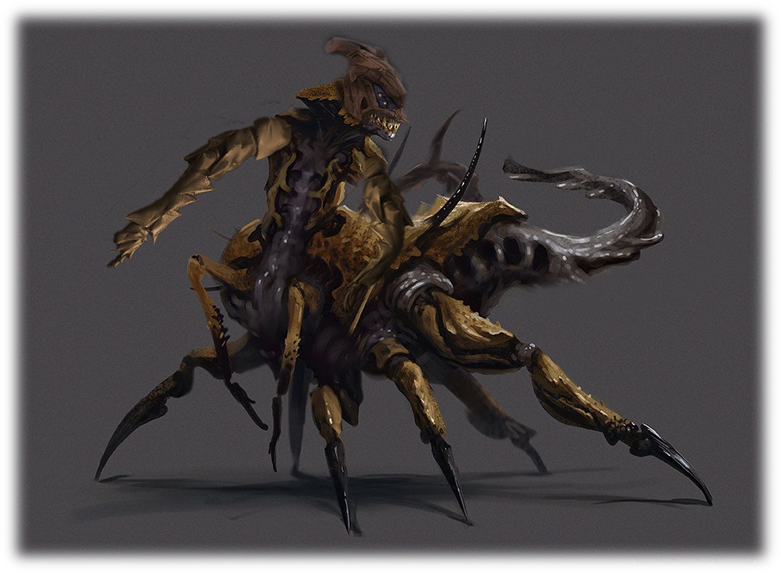
Physiology
The Nafkan were once of the most fearsome galactic horrors of recorded history. Once a terrifying hive mind intent on devouring the galaxy, after successive defeats during the ravenous wars, something remarkable happened. The Zeta-Nafkan spawned, a divergent hive mind that fled from civilised space, and later become completely autonomous sentient organics. Zeta-Nafkan otherwise share the same physiology as the Nafkan, which will be detailed below.
Zeta-Nafkan are part insectoid with a dense chitinous armour granting them some natural resistance. They have six legs, two quite frail grasping forelimbs, used to secure already immobile food, and two more rugged arms. Measured at full length, Zeta-Nafkan are 9’6” on average. This size and strength already makes them naturally fierce combatants, but then paired with their long forked tail, the Zeta-Nafkan can unleash devastating and sudden whip attacks that can knock opponents unconscious, at the mercy of the Zeta-Nafkan.
Thought to be a remnant of their time as a hive mind, Zeta-Nafkan possess a short range telepathy that allows them to commune with one another, and with any other creatures in their range.
Zeta-Nafkan have relatively short lives as far as sentient races go, though their high birth rate more than makes up for that. It was this high birth rate, combined with their more rapid maturity, that allowed swarms of Nafkan to originally terrorise the galaxy.
Zeta-Nafkan, like their predecessors, also have a ravenous appetite – requiring four times the food most galactic races eat to sustain themselves. This is thought to be why the Nafkan Devourers had such an aggressive and terrifying goal in their lifetime. Fortunately, Zeta-Nafkan have found themselves able to eat other food, not sentient organics.
Zeta-Nafkan have an average life expectancy of 64 years, reaching adulthood at the age of 10.
Origin Theory
During the ravenous wars, the Nafkan used large and advanced spacecraft to travel. As the war waged on, and these craft were gradually destroyed, they could not replace them.
Because of this, it is thought that the Nafkan never truly achieved stellar flight themselves, but instead scavenged ships and other technology from the now lost stellar species that they devoured.
Some take this theory further and wonder if the Nafkan were a genetically engineered creation of one such lost empire, only to turn into an uncontrollable galactic menace.
Much research is still ongoing into where the Nafkan came from, and exactly how they spread out to devour such large swathes of the galaxy.
Significant Historical Events
The Start of the Ravenous Wars, GY 6754 – The republic, allied with Othari Industries, officially declared war upon the Nafkan Devourers, declaring them a galactic menace that should be wiped from the galaxy with impunity. The wars would be incredibly bloody and fierce, but would eventually culminate in the destruction of the Nafkan.
The Zeta-Nafkan Divergence, GY 6862 – As the stellar coalition, led by the republic, gained an upper hand in the Ravenous Wars, an incredibly profound event occurred – the Nafkan hive mind split. The new divergent hive mind would go on to become the Zeta-Nafkan and became fearful of the war and the existential continuity of their people. The divergence hive mind and its drones fled to the far reaches of the galaxy, away from civilised space. Over time, the hive mind lost, or perhaps relinquished, control over its drones, and the Zeta-Nafkan became completely autonomous drones.
The Qirus Treaty, GY 6945 – After the destruction of the Nafkan, the republic and their allies found the Zeta-Nafkan. The republic assumed them hostile and sent navies to them, though, after some sad and unfortunate skirmishes, found the Zeta-Nafkan to be sentient creatures, begging for peace. Apprehensive of their true intentions after almost two centuries of war, the republic and their allies drew up the Qirus Treaty, granting the Zeta-Nafkan basic rights and a single planet, Greater Qirus, and some surrounding barren solar systems, to inhabit without interference. While this was celebrated intensely by the Zeta-Nafkan, over time it became apparent that Greater Qirus was highly unstable and destined to tear itself apart. Whether the republic and its allies knew of the future of Greater Qirus is still a topic for conspiracy theories to this day.
Organisation
The Zeta-Nafkan State are an extremely fledgling stellar empire, almost entirely dependant on the generosity, or salvage, of other empires to even begin to understand the intricacies of stellar travel and modern life.
The Zeta-Nafkan State is organised effectively as an anarcho-socialist society, with no clearly defined ruling class. For matters of import, the Zeta-Nafkan will elect a temporary speaker to act on their behalf. On a smaller scale, Zeta-Nafkan settlements will act as a community when making decisions. For some philosophers, the Zeta-Nafkan represent a unique and precious example of a truly equal society.
Shared Values/Beliefs
Despite their once bloody origins, and fierce appetite, the Zeta-Nafkan are thought to be pacifist on the whole, likely due to the political scarring of their last wars.
Zeta-Nafkan are also thought to be quite an insular community, though this may be due to the discrimination of any Zeta-Nafkan in the wider galaxy, forcing them to stand together.
Controlled Planets/Population Centres
Greater Qirus (System: Qirus) – An extremely unpleasant and unstable sulfuric planet, Greater Qirus is the sole planet granted to the Zeta-Nafkan. Were the Zeta-Nafkan state to formerly colonise another planet, they would breach their peace treaty with the republic and their old allies. Greater Qirus has only become more and more unstable however, and it is predicted by many scientists to tear itself dramatically apart within the half-century, making the fate of the Zeta-Nafkan a modern moral crisis.
Comments